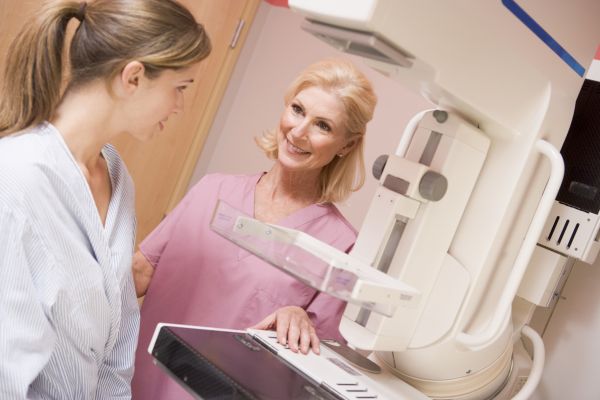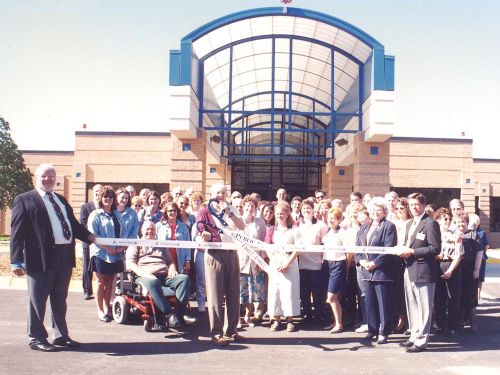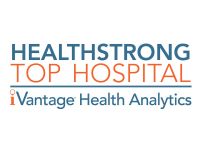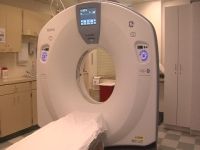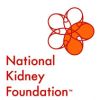Tuesday, May 20, 2014
Every Month Should be Breast Cancer Awareness Month
Even though October is named breast cancer awareness month, we at Prairie Lakes think it is a topic that needs to be brought up more than a month a year. By taking these steps, early detection is possible when the cancer is the most treatable.
1. Mammogram
Screening should begin by age 40, unless there is a family history. In that case screenings should be earlier.
2. Self-Exams
Look for swelling, warmth, redness, darkening of breast tissue, change in breast shape or size, itching, sores, inverting nipples and new or acute breast pain.
3. Genetic Testing
If patients have family history, undergoing these tests that search for “cancer gene” is a good idea.
4. Healthy Weight
People who are overweight produce more estrogen which is associated with increased risk for breast cancer.
5. Wholesome Diet
Here is a breast cancer-fighting diet to go by:
-Vitamin D
-Folate (orange juice, spinach, asparagus, etc.)
-Vegetables
-Omega-3 Fatty Acids (salmon, walnuts, etc.)
-Antioxidants (blueberries and green tea)
Published in
News and Announcements
Tuesday, May 20, 2014
BASH Took Our Breath Away
The Prairie Lakes Healthcare Foundation hosted BASH (Building A Superior Hospital) on Saturday, April 12 at the Watertown Event Center. This annual gala event is a friend and fund raiser for the Foundation. What a night! Three hundred sixty five guests were in attendance, an increase from last year.
Dollars raised at the event and donations gathered through solicitation equated to $94,000, with the event netting $60,000—an increase from last year. Proceeds from the annual gala will be used to enhance pulmonology services at Prairie Lakes. Full-time pulmonology services were introduced to the region the fall of 2013 with the opening of the Prairie Lakes Pulmonology Clinic in Watertown and the addition of Dr. Jeffrey Kowitz, pulmonologist, to the medical staff.
Corporate sponsorships were introduced this year to raise more funds. Brown Clinic, CPSI, Glacial Lakes Energy, Redlinger Bros. P&H and ReliaBank were $3,000 corporate sponsors. There were 18- $1,000 cash sponsors in addition to smaller cash donors. Those providing monetary donations, items for the auction/ raffle and winning bids are greatly commended for their generosity. Special thanks to the BASH committee for their time and talents. There is no success without the donors, volunteers and attendees.
The mission of the Prairie Lakes Healthcare Foundation is: Healthcare is a vital component of a community’s quality of life. Prairie Lakes Healthcare Foundation exists to raise funds with which to support and advance the health services available to the Watertown area through Prairie Lakes Healthcare System.
Published in
News and Announcements
Tuesday, May 13, 2014
Eat Fiber, Live Longer
Being a victim of a heart attack is scary enough. What is even scarier is the risk of having another heart attack or eventually dying from heart disease. So what steps can patients take to prevent this from happening?
According to a study from the British Medical Journal, people who have suffered from a heart attack have a better possibility of living longer if they increase their consumption of fiber. After conducting a study, scientist discovered patients who ate the most fiber had a 25% reduced chance of dying in the 9 years after their heart attack than those we did not increase their fiber intake.
Fiber can be found in many foods such as:
Vegetables
Beans
Fruits
Nuts and seeds
Breads (especially rye and wheat)
Cereals
While there are many other lifestyle changes patients will have to make after suffering from a heart attack, scientist believe that increasing your fiber intake will help your overall health and recovery.
Published in
News and Announcements
Tuesday, May 06, 2014
Skin Saving Tips
May is Melanoma Awareness Month, and with warm weather on the horizon, it is a good time to remind ourselves how to take care of our skin.
Almost 80,000 people will be diagnosed with melanoma this year. Here are some tips from the Melanoma Research Foundation on how to protect your skin:
•To protect yourself from harmful UVA and UVB rays always wear broad spectrum sunscreen with at least SPF 30.
•Wear brimmed hats to protect your face, and do not forget to apply sunscreen to your ears, neck and shoulders.
•When in the water or sweating reapply sunscreen every 40 minutes.
•Avoid tanning beds. The World Health Organizations International Agency for Research on Cancer (IARC) classifies tanning beds in the highest cancer risk category.
•Be up to date with the new FDA sunscreen labels and check for a notice that the product has been shown to help prevent skin cancer and premature aging.
•Conduct skin checks on a monthly basis and schedule a yearly appointment with a dermatologist.
Always be aware of changes on your skin and call your doctor if anything looks out of the ordinary. Remember there is no such thing as a safe tan. Tanned skin is a result of damaged skin cells and one blistering sunburn can double the chances of getting melanoma.
Published in
News and Announcements
Friday, May 02, 2014
7 Tips for a Better Night Sleep
Feeling worn out or crabby? Sleeping may be your solution. 50 to 70 million US adults suffer from sleep issues.
There are many reasons why Americans experience sleep insufficiency like work schedules, family issues, illness, etc. These societal factors play a huge role in how a person sleeps, and while you may not be able to control all those factor here are 7 helpful habits that may help you catch up on some Z’s.
1.Bedtime Ritual
Read a book or take a bath before bed. By doing a relaxing activity every night before you go to bed will promote better sleep.
2. Sleep Schedule
Although easier said than done, try and go to bed and get up at the same time everyday. This will help your body’s sleep-wake cycle stay on track.
3. Comfort
Make sure your room is ideal for sleeping. Having appropriate bedding, blinds and the right temperature will make for a sound night's sleep.
4. Don’t Go To Bed on E
Going to bed hungry or starved will make for a discomforting night sleep. Also watch how much you drink before you go to bed to limit your late night trips to the bathroom.
5. Limit Naps
Naps can interfere with nighttime sleep. If a nap is needed, limit yourself to about 10 to 30 minutes.
6. Physical Activity
Regular physical activity will help you enjoy a deeper sleep and will help you fall asleep faster.
7. Manage Stress
Making a to do list in your head for you next day is not a great start to a good night sleep. Try to find healthy ways to manage your stress like getting organized and delegating tasks.
Sleep is too important to ignore. People who suffer from sleep insufficiency are more likely to suffer from hypertension, depression, diabetes and more. If you are having trouble sleeping you may need to contact your doctor. Click here to learn more about sleep studies and how the doctors at Prairie Lakes can help.
Published in
News and Announcements
Friday, April 25, 2014
Cancer Center Commemorates 15 Years
Fifteen years ago this week, the Prairie Lakes Cancer Center opened its doors and started caring for patients. Through the years, the Cancer Center has grown to serve the needs of patients—adding on to the building and doubling the size of the staff. Today, the Cancer Center sees over 350 new patients a year and averages over 40 visits per day.
The history of cancer care in Watertown started long before the Cancer Center opened its doors 15 years ago. Medical oncology services were already being provided at Prairie Lakes in the Outreach Department when discussions to add radiation oncology services started in 1997. In 1998, a study was done and it concluded that Watertown could support the addition of radiation oncology services. The board approved the project and later that year construction started on the Cancer Center.
“Community support was essential to the establishment of the Prairie Lakes Cancer Center,” said Jill Fuller, CEO. “The board of directors saw the need to offer comprehensive cancer care locally and the community rallied behind the project, contributing over $2 million.”
Through the years, the Cancer Center has had many milestones.
- In February 2002, Prairie Lakes was the first site in the state to offer Intensity Modulated Radiation Therapy (IMRT), an advanced, new radiation therapy procedure that allows for concentration of the radiation dose to the tumor site, while sparing normal surrounding tissue from unnecessary radiation exposure.
- In July 2004, the Cancer Center started offering PET scanning. With this technology a physician can view internal images of a patient’s whole body and identify cells that grow at a very fast rate.
- In July 2007, the Cancer Center invested in a revolutionary new treatment delivery system called TomoTherapy. Prairie Lakes was one of four cancer centers in a six state region to offer TomoTherapy. Unlike traditional radiation therapy equipment, the TomoTherapy system’s treatment delivery unit doubles as an on-board CT scanner that allows images of a patient’s anatomy to be created with the same equipment that delivers the radiation prior to each treatment.
- In July 2011, the Cancer Center began participating in clinical trials.
- In 2012, Prairie Lakes was one of the first cancer centers in region to offer Provenge infusion therapy, the only FDA-approved prostate cancer immunotherapy for men with advanced prostate cancer.
- In August 2013, Prairie Lakes was the second cancer center in South Dakota to offer Xofigo (radium 223), a treatment for men with advanced prostate cancer that has spread to their bones.
Today, the Cancer Center continues to evolve to incorporate advances in technology and new treatments. The Cancer Center offers an interdisciplinary approach to treating patients, recognizing that patients have a variety of needs.
“There’s no place like home, especially when you are sick,” said Dr. Jeffrey Brindle, radiation oncologist. “From the staff greeting you by your first name when you walk in the door to offering the latest treatments and technology, we strive to give our patients and their families the best care and support system right here in Watertown.”
Published in
News and Announcements
Tuesday, April 15, 2014
Heart Failure Protection
Just because you have suffered from a heart attack doesn’t mean you can’t live a full and healthy life. New studies have found a way to protect patients from heart failure, a chronic condition that can occur after a heart attack.
Heart failure occurs when the heart isn’t pumping enough blood to the body. You can develop heart failure in many ways.
- Coincides with diabetes and high blood pressure
- Family history of heart disease
- Have had a heart attack or coronary artery disease
It is estimated that 5 million American have heart failure and it is the most common reason for people over the age of 65 to be hospitalized. That is why new research from UConn Health is so important.The research discovered that a specific “ion channel” in the heart can protect against heart failure. Ion channels are receptor proteins, and this one in particular uses nitric oxide which Dr. Bruce T. Lian says “has long been known to prevent heart failure. What’s unique here is that this receptor channel directly associates with the enzyme that makes nitric oxide with a localized increase at strategic sites within the muscle cell.”
This new mechanism may be the best approach for helping patients with heart failure, and preventing it in others. “Preventing a condition like heart failure is always a much better option for patients”, said Laing.
Published in
News and Announcements
Monday, April 07, 2014
Prairie Lakes Named 2014 HEALTHSTRONG™ Hospital
Prairie Lakes Healthcare System has been named a 2014 HEALTHSTRONG™ Hospital by iVantage Health Analytics. Prairie Lakes was among 547 hospitals nationwide selected for this honor—ranking in the top 13% of the 4,299 hospitals studied. The purpose of the HEALTHSTRONG™ Hospital study was to provide a comprehensive comparison of acute care hospitals across a continuum of quality, population health, outcomes and financial indicators.
“Prairie Lakes is proud to be recognized as a HEALTHSTRONG Hospital. We place a tremendous emphasis on quality of care, patient satisfaction and financial stability,” said Jill Fuller, CEO of Prairie Lakes. “This honor is proof positive that our efforts are making a difference to the hospital and the communities we serve.”
The 2014 HEALTHSTRONG Hospitals highlights top performing hospitals rated as part of iVantage’s Hospital Strength INDEX™. The Hospital Strength INDEX is a comprehensive rating system of hospitals and the results recognize the top performing hospitals—measuring them across 66 different performance metrics, including quality, value-based outcomes, patient perspective, affordability, financials and efficiency.
“The Hospital Strength INDEX analysis reveal that geographic variation, population health and superior performance are interrelated, and that they can result in lower cost, better outcomes and healthier communities nationwide,” said John R. Morrow, executive vice president of iVantage Health Analytics.
Published in
News and Announcements
Tuesday, April 01, 2014
Occupational Therapist: Living Life to its Fullest
April is Occupational Health Month, which means it is a great time to thank your occupational therapist and occupational therapy assistants. Through their work they give customized and holistic assistance to those in need. The specialized support they give to children with disabilities and to people recovering from injuries is truly remarkable. The work of occupational therapist allows others to live life to the fullest.
Here at Prairie Lakes Healthcare System, our occupational therapist help a wide variety of patients, but they also specialize in Lymphedema Management. Lymphedema is the accumulation of lymphatic fluid that collects in the tissue and causes swelling in limbs and other places of the body. Our staff members are certified in Manual Lymph Drainage and Complete Decongestive Therapy techniques.
Occupational therapists are faced with unique cases on a daily basis and treat each patient with their own specific needs. Please take the time to thank your occupational therapist as they help you through your rehabilitation journey and allow you to live your life to the fullest.
Published in
News and Announcements
Thursday, March 27, 2014
Detecting Early Stages of Cancer
Get screened and early detection are common words you hear from experts in the medical field. Many shrug at these words thinking “that will never happen to me”, until it does. While getting screened won’t stop or cure cancers, it does allow doctors to find cancer cells at early stages when it is the most curable.
Most recent studies from the Swedish American Health System show that Low Dose CT scans can now detect early stages of cancer, such as lung cancer. According to the American Cancer Society, more than 150,000 people die each year from lung cancer. People with greater risk of lung cancer are those between 55 and 74 years of age, former and current smokers and those exposed to asbestos.
John Myers, Chairman of surgery at Swedish Americans says, “right now only 15% of lung cancers are cured. If we can go to 30%, 40% or 50% by diagnosing earlier we need to do that”.
So even though it may get old hearing how you should be getting screened for all sorts of cancers, do it. These simple screenings that take 30 minutes could potentially save your life.
Published in
News and Announcements
More...
Thursday, March 20, 2014
Spring Clean your Health
What is it about Spring that makes everything seem so fresh and new? With Spring comes the type of attitude “out with the old in with the new”.
Here are five steps to help jumpstart your Spring in a healthy and fresh way:
1- Adios Germs
It’s Spring cleaning time! Staying healthy and fighting sickness is one of the first steps in starting out fresh this spring. Not only do clean spaces make us happier and more productive, it helps combat all the sickness lingering from the winter months.
Start with tossing sponges after 8 weeks, getting a new toothbrush every 3 months and consider replacing all dish towels and cutting boards as they are not immune to the wear and tear that leads to extra germs. Get dusting and remove all those dust bunnies that can lead to allergies, hives and even asthma attacks. Finally, declutter your workspace. Clutter on your desk contributes to 10 million germs lurking around your workspace. Wipe down your keyboard, mouse and phone everyday.
2- Make your kitchen a healthy space
Now is the time to throw away all the unhealthy foods that we collected over the winter months. Give your kitchen a healthy makeover by removing all processed foods and replace them with natural, whole foods like vegetables, fruits and nuts.
3- Take your workouts outside
There is nothing like breathing in that fresh air after being cooped up all winter long. Now that the temps are up, head outside for your workouts. Discover your passion for running, hiking or biking while breaking free from the sweaty, germ-filled gym. Soak up the sun and get a fresh sense of renewal.
4- Giver your body a much needed detox
We are not talking about a detox diet, but a more natural way of detoxing your body by exercising and eating right. Cut out the alcohol and refined sugars and start eating healthier. This will make you feel rejuvenated and does wonders for your mood.
5- Go see your doctor
Spring is a great time to get checked out for your annual physical. By taking the appropriate measures and checking in with your ob-gyn, dentist, optometrist and family doctor may help prevent emergencies and late detection from occurring.
These five great steps will give you a jumpstart to a more active you, and what a better time than Spring to start on a healthy track.
Published in
News and Announcements
Tuesday, March 11, 2014
National Colorectal Cancer Awareness Month
Did you know that colorectal cancer is one of the most detectable and curable cancers? So why is it that this cancer is also the second leading cause of cancer deaths?
The lack of knowledge and routine screenings make colorectal cancer so deadly. Which is why March is National Colorectal Cancer Awareness month. This is the time to the word out about how important it is to get screened. Unless you are at high risk or have family history, people 50 years or older should be getting screened for colon cancer. If detected early enough, these screenings could save your life. In fact, 90% of all colon cancer cases can be prevented with recommended screenings.
A polyp is usually the first sign of colon cancer. Those polyps should not be there and overtime can turn into cancer. By getting routine screenings such as a colonoscopy, polyps can be found and removed before turning into cancer. Professionals in this field believe that a widespread adoption of these screening practices could save as many as 30,000 lives a year.
Along with routine screenings, the American Cancer Society also suggest eating healthy and living an active lifestyle can prevent colorectal cancer. Here are their suggestions:
-Increase physical activity
-Limit red and processed meats
-Get recommended levels of vitamin D and calcium
-Eat more fruits and vegetables
-Avoid obesity and weight gain
-Avoid excess alcohol
Published in
News and Announcements
Thursday, March 06, 2014
Aging and Kidney Disease
While kidney disease can develop at anytime, it is more likely to occur in those 60 or older. Researchers from John Hopkins University have found that more than 50% of seniors over 75 are believed to have kidney disease.
Kidney disease can sometimes be hard to detect since it develops slowly and with very few symptoms. “Many people don’t realize that, as we age, we lose kidney function,” said Beth Piraino, MD National Kidney Foundation President. “Unfortunately older Americans may not realize they are at increased risk until it’s too late.”
Those with diabetes, high blood pressure and family history of kidney failure are more at risk than others. Becoming aware of kidney disease is the first step in prevention.
The National Kidney Foundation encourages everyone over the age of 60 to be screened for kidney disease. World Kidney Day is on March 13, 2014.
Published in
News and Announcements
Tuesday, March 04, 2014
Prairie Lakes Doctor Honored for Work in Haiti
Dr. Henri Lanctin, a urologist at Prairie Lakes Healthcare System, was honored on February 22, 2014, in Brooklyn, NY, by the Aesclepius Medical Society for his work to improve urological care in Haiti.
"Dr. Lanctin was selected because of his outstanding medical care he has been providing to the indigenous population of Pignon, Haiti, for the past few years," said Nicole Francis of the Aesclepius Medical Society. "Dr. Lanctin is instrumental in the practical medical education of the urology residents of the Faculty of Medicine and he has worked diligently to bridge the gap between the different foreign medical entities providing urological services in Haiti."
Dr. Lanctin has been actively involved in Project Haiti, a nonprofit organization committed to improving the quality of life for the people of Haiti, for 3.5 years. In addition to sending teams to the area to provide medical care for the community, Project Haiti puts a strong emphasis on providing medical education to Haiti's own health care workers. Dr. Lanctin has organized and led many urology teams to Pignon, Haiti, where team members work side-by-side with Haitian urologists.
"Haiti has 26 urologists," said Dr. Lanctin. "The goal of our work in Haiti is to work with these urologists—teaching them, supporting them and increasing their knowledge of urological care."
In November 2013, an international committee was formed to try to coordinate urological care efforts in Haiti. Dr. Lanctin is part of this committee, which includes both administrators and doctors from America and Haiti. The committee’s goal is get a bigger return on the efforts to improve urological care in Haiti.
"This award was very unexpected," said Dr. Lanctin. "I do not do this work for personal accolades. I do it for the love of the Haitian people."
Published in
News and Announcements
We can help you find a doctor. Call 605-882-7000 or search online.
